
Star Wars is an American epic space opera media franchise created by George Lucas, which began with the eponymous 1977 film and quickly became a worldwide pop culture phenomenon. The franchise has been expanded into various films and other media, including television series, video games, novels, comic books, theme park attractions, and themed areas, comprising an all-encompassing fictional universe. Star Wars is one of the highest-grossing media franchises of all time.

Return of the Jedi is a 1983 American epic space opera film that is the sequel to Star Wars (1977) and The Empire Strikes Back (1980). It is the third installment in the original Star Wars trilogy and the sixth chronological film in the "Skywalker Saga". It is directed by Richard Marquand based on a screenplay by Lawrence Kasdan and George Lucas from a story by Lucas, who was also the executive producer. The film follows the ongoing struggle between the malevolent Galactic Empire and the freedom fighters of the Rebel Alliance. As the Rebels attempt to destroy the Empire's second Death Star, Luke Skywalker hopes to bring his father, Darth Vader, back from the dark side of the Force. The film stars Mark Hamill, Harrison Ford, Carrie Fisher, Billy Dee Williams, Anthony Daniels, David Prowse, Kenny Baker, Peter Mayhew and Frank Oz.
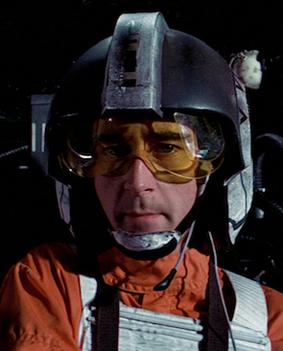
Wedge Antilles is a fictional character in the Star Wars franchise. He is a supporting character portrayed by Denis Lawson in the original Star Wars trilogy, and voiced by David Ankrum in Episode IV – A New Hope (1977) and Rogue One (2016). He is also featured in the Star Wars expanded universe, most notably as the lead character in most of the X-Wing novels. Antilles has also appeared in the sequel trilogy film The Rise of Skywalker (2019), with Lawson reprising his role; in the 2014 animated series Star Wars Rebels, voiced by Nathan Kress; and in the 2023 second volume of Star Wars: Visions, voiced again by Lawson.

Luke Skywalker is a fictional character and the protagonist of the original film trilogy of the Star Wars franchise created by George Lucas. Portrayed by Mark Hamill, Luke first appeared in Star Wars (1977), and he returned in The Empire Strikes Back (1980) and Return of the Jedi (1983). Over three decades later, Hamill returned as Luke in the Star Wars sequel trilogy, with a cameo in The Force Awakens (2015) before playing a major role in The Last Jedi (2017) and The Rise of Skywalker (2019). He later played a digitally de-aged version of the character in the Disney+ series The Mandalorian, appearing in the second-season finale, which premiered in 2020, and The Book of Boba Fett, in the sixth episode, released in 2022.
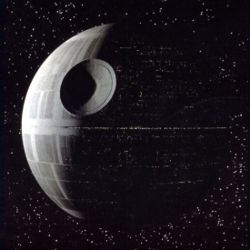
The Death Star is a fictional space station and superweapon featured in the Star Wars space-opera franchise. Constructed by the autocratic Galactic Empire, the Death Star is capable of obliterating entire planets, and serves to enforce the Empire's reign of terror. Appearing in the original 1977 film Star Wars, the Death Star serves as the central plot point and setting for the movie, and is destroyed in an assault by the Rebel Alliance during the climax of the film, with the 2016 prequel film Rogue One and the 2022 television series Andor exploring its construction. A larger second Death Star is being built in the events of the 1983 film Return of the Jedi, featuring substantially improved capabilities compared to its predecessor, before it is destroyed by the Rebel Alliance while under construction.
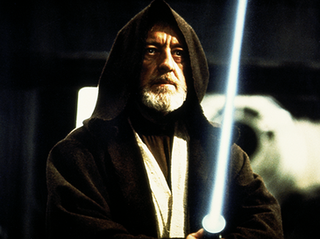
Obi-Wan Kenobi is a fictional character in the Star Wars franchise. Within the original trilogy, Obi-Wan is a Jedi Master as a supporting character and is portrayed by English actor Alec Guinness. In the later-released prequel trilogy, a younger version of the character serves as one of the two main protagonists, alongside Anakin Skywalker, and is portrayed by Scottish actor Ewan McGregor. In the original trilogy he is introduced as Ben Kenobi, an alias he uses while in hiding from the Empire. He is a mentor to Luke Skywalker, to whom he introduces the ways of the Jedi. After sacrificing himself in a duel against Darth Vader, Obi-Wan guides Luke through the Force in his fight against the Galactic Empire. In the prequel trilogy, set two decades earlier, he is initially a Padawan (apprentice) to Jedi Master Qui-Gon Jinn, and later mentor and friend of Luke's father Anakin, who falls to the dark side of the Force and becomes Vader. The character briefly appears in the sequel trilogy as a disembodied voice, speaking to protagonist Rey, and serving as the namesake of Ben Solo. He is frequently featured as a main character in various other Star Wars media, including the streaming television miniseries Obi-Wan Kenobi, in which McGregor reprised the role.

Yoda is a character in the Star Wars franchise. He is a small, green humanoid alien who is powerful with The Force. He is a Jedi Master and a leader in the Jedi Order. Frank Oz voiced and puppeteered Yoda in the 1980 film The Empire Strikes Back, which was the character's first appearance. Oz reprised the role in Return of the Jedi (1983), The Phantom Menace (1999), and The Last Jedi (2017). Yoda has also appeared in television series, comics, novels, video games and commercials. Outside of the films, the character has been voiced most frequently by Tom Kane.

Fleet Admiral Gial Ackbar is a fictional character from the Star Wars franchise. A member of the amphibious Mon Calamari species, Ackbar was the foremost military commander of the Rebel Alliance, and he led the attack against the second Death Star in Star Wars: Return of the Jedi (1983), the final entry in the original Star Wars trilogy. Although his time in the film was brief, Ackbar became a prominent character in other Star Wars media, including novels, comic books, video games, and television shows, and later made appearances in the sequel trilogy films Star Wars: The Force Awakens (2015) and Star Wars: The Last Jedi (2017), and the television series The Clone Wars.
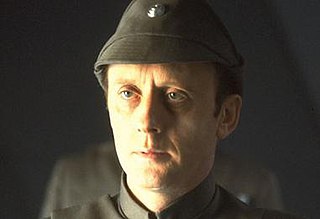
Admiral Firmus Piett is a fictional character from the Star Wars franchise, first introduced and portrayed by Kenneth Colley in the 1980 film The Empire Strikes Back. As a supporting villain in command of Darth Vader's flagship, Executor, Piett is generally considered to be the most prominent Imperial officer in the film. He subsequently appeared in the sequel Return of the Jedi, making him the only officer in the original trilogy to appear in more than one film and be portrayed by the same actor. Piett also appears in the canon Star Wars novel Lost Stars, and is featured in several more novels, comic books, and video games within the Star Wars Legends line.

Star Wars: Shadows of the Empire is a 1996 multimedia project created by Lucasfilm. The idea was to create a story set between the films The Empire Strikes Back and Return of the Jedi, and to explore all commercial possibilities of a full motion picture release without actually making a film. The venture was intended to reinvigorate interest in the franchise ahead of the theatrical Special Editions of the Star Wars trilogy released the following year.

Super Star Wars: The Empire Strikes Back, also known as Super Empire Strikes Back, is a 1993 action video game developed by LucasArts and Sculptured Software and published by JVC Musical Industries for the Super Nintendo Entertainment System. It is based on the 1980 film The Empire Strikes Back and is the sequel to Super Star Wars. The game was followed by a sequel, Super Star Wars: Return of the Jedi in 1994. Unlike its predecessor, Nintendo wasn’t involved in its publishing. The game was re-released on the Wii's Virtual Console in North America on August 24, 2009 and in the PAL regions on October 2, 2009, alongside the other games in the Super Star Wars series.

Super Star Wars: Return of the Jedi, also known as Super Return of the Jedi, is a 1994 action video game developed by LucasArts and Sculptured Software and published by JVC Musical Industries for the Super Nintendo Entertainment System. It is a sequel to Super Star Wars (1992) and Super Star Wars: The Empire Strikes Back (1993) and is based on the 1983 film Return of the Jedi. It was ported to the Game Boy and Game Gear by Realtime Associates, which were published by THQ in 1995. The game was re-released on the Wii Virtual Console in North America on September 7, 2009 and in PAL regions on October 16, 2009, alongside the other games in the Super Star Wars series.
The Empire Strikes Back is a 1980 film in the Star Wars saga. It may also refer to:

Sheev Palpatine is a fictional character in the Star Wars franchise created by George Lucas. He first appears on screen in The Empire Strikes Back (1980), in which he is credited as The Emperor, and is the overarching antagonist of the three film trilogies in the Skywalker Saga, in which he is portrayed by Ian McDiarmid. The character is also known by his Sith name, Darth Sidious, which was first used in the novelization of The Phantom Menace (1999). In creating Palpatine, Lucas was inspired by real-world examples of democratic backsliding during the rise and rule of dictators such as Julius Caesar, Napoleon Bonaparte, and Adolf Hitler.
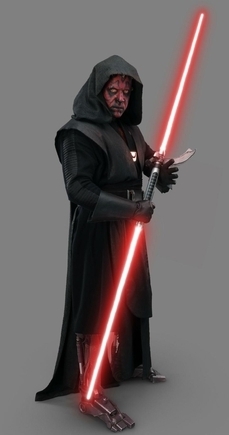
Darth Maul, later known simply as Maul, is a character in the Star Wars franchise. He first appeared in the 1999 film Star Wars: Episode I – The Phantom Menace as a powerful Sith Lord and Darth Sidious' first apprentice. Though seemingly killed by Obi-Wan Kenobi at the end of the film, Darth Maul returned in the 2008 animated series Star Wars: The Clone Wars. Star Wars creator George Lucas had intended for the resurrected Maul to serve as the main antagonist of the sequel film trilogy, but these plans were abandoned when Disney acquired Lucasfilm in 2012. The character nonetheless reappeared in the 2014 animated series Star Wars Rebels and the 2018 film Solo: A Star Wars Story, voiced again by Witwer; Park physically reprised the role in Solo. Since his initial defeat in The Phantom Menace, Maul has become an independent criminal mastermind and endured as Obi-Wan's archenemy.
Star Wars has been expanded to media other than the original films. This spin-off material is licensed and moderated by Lucasfilm, though during his involvement with the franchise Star Wars creator George Lucas reserved the right to both draw from and contradict it in his own works. Such derivative works have been produced concurrently with, between, and after the original, prequel, and sequel trilogies, as well as the spin-off films and television series. Commonly explored Star Wars media include books, comic books, and video games, though other forms such as audio dramas have also been produced.

Jabba Desilijic Tiure, more commonly known as Jabba the Hutt, is a fictional character and major antagonist in the Star Wars franchise. Created by George Lucas, Jabba is voiced by Larry Ward with several puppeteers inside a one-ton puppet portraying him in Return of the Jedi. He was originally supposed to first appear in Star Wars (1977) as a stop motion character with Declan Mulholland as his stand-in. Jabba was later added into the film as a CGI character when it was re-released in Special Edition in 1997. He also appears in the prequel movie The Phantom Menace. The character is a large slug-like creature based on annelid worms, but he was originally designed as an apelike figure.

Star Wars Jedi Knight: Mysteries of the Sith is an expansion pack for the 1997 first-person shooter Star Wars Jedi Knight: Dark Forces II, developed and published by LucasArts for Microsoft Windows in 1998. It was re-released on Steam in September 2009. The expansion includes a new single-player story mode and fifteen multiplayer maps. The single-player story, set in the fictional Star Wars expanded universe five years after the events of Dark Forces II, follows both returning protagonist Kyle Katarn, a Jedi Master and mercenary working for the New Republic, and Mara Jade, a character featured in numerous Star Wars expanded universe works, who is being trained by Katarn in the Jedi arts. After Katarn goes missing while investigating an ancient Sith temple, Jade continues her studies on her own while undertaking missions from the New Republic, eventually leaving to find Katarn.

Star Wars: Tales is an American animated anthology television series created by Dave Filoni for the streaming service Disney+. Each installment consists of six shorts that explore different characters from the Star Wars franchise. The first, Tales of the Jedi, explores Jedi from the prequel trilogy era, while the second, Tales of the Empire, explores characters related to the Galactic Empire. The series is produced by Lucasfilm Animation, with Charles Murray as head writer and Filoni as supervising director.
















